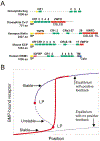Shaping BMP morphogen gradients in the Drosophila embryo and pupal wing
- PMID: 16368928
- PMCID: PMC6469686
- DOI: 10.1242/dev.02214
Shaping BMP morphogen gradients in the Drosophila embryo and pupal wing
Abstract
In the early Drosophila embryo, BMP-type ligands act as morphogens to suppress neural induction and to specify the formation of dorsal ectoderm and amnioserosa. Likewise, during pupal wing development, BMPs help to specify vein versus intervein cell fate. Here, we review recent data suggesting that these two processes use a related set of extracellular factors, positive feedback, and BMP heterodimer formation to achieve peak levels of signaling in spatially restricted patterns. Because these signaling pathway components are all conserved, these observations should shed light on how BMP signaling is modulated in vertebrate development.
Figures





References
-
- Aono A, Hazama M, Notoya K, Taketomi S, Yamasaki H, Tsukuda R, Sasaki S and Fujisawa Y (1995). Potent ectopic bone-inducing activity of bone morphogenetic protein-4/7 heterodimer. Biochem. Biophys. Res. Commun 210, 670–677. - PubMed
-
- Araujo H, Negreiros E and Bier E (2003). Integrins modulate Sog activity in the Drosophila wing. Development 130, 3851–3864. - PubMed
-
- Arora K and Nusslein-Volhard C (1992). Altered mitotic domains reveal fate map changes in Drosophila embryos mutant for zygotic dorsoventral patterning genes. Development 114, 1003–1024. - PubMed
-
- Arora K, Levine MS and O’Connor MB (1994). The screw gene encodes a ubiquitously expressed member of the TGF-beta family required for specification of dorsal cell fates in the Drosophila embryo. Genes Dev. 8, 2588–2601. - PubMed
-
- Ashe HL and Levine M (1999). Local inhibition and long-range enhancement of Dpp signal transduction by Sog. Nature 398, 427–431. - PubMed
Publication types
MeSH terms
Substances
Grants and funding
LinkOut - more resources
Full Text Sources
Molecular Biology Databases

